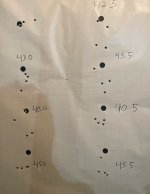Hello all,
I've attached a photo of my OWC results and it looks like my charge range is 44.5-45.0?
These are 175SMKs using N550. I have velocity details as well but was able to work up to 45.5 (max charge is 45.7) with no pressure signs. Obviously, recoil was noticeable at 45.5. Also, I accidentally wrote 40.0-40.5 which is actually 44.0-44.5. Sorry.
I've attached a photo of my OWC results and it looks like my charge range is 44.5-45.0?
These are 175SMKs using N550. I have velocity details as well but was able to work up to 45.5 (max charge is 45.7) with no pressure signs. Obviously, recoil was noticeable at 45.5. Also, I accidentally wrote 40.0-40.5 which is actually 44.0-44.5. Sorry.


